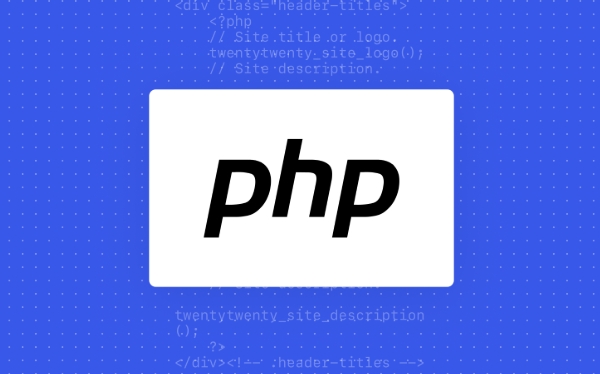PHP preg_quote to escape regex characters
Jul 13, 2025 am 01:54 AMWhen processing regular expressions, when you need to insert user input or external data into the regular as a literal string, the preg_quote() function needs to be used to escape special characters. 1. When a variable contains special characters in a regular (such as ., *, , ?) and is spliced into a regular expression, it will cause abnormal matching behavior; 2. The first parameter of preg_quote() is a string to be escaped, and the second parameter is used to specify the regular separator to ensure that the separator itself is also escaped; 3. Common misunderstandings include abuse of preg_quote(), ignoring the delimiter parameters, and mistakenly thinking that it can solve all security problems; 4. In practical applications, it is recommended to always use preg_quote() to process dynamic content and develop standard writing methods: $pattern = '/' . preg_quote($search_term, '/') . '/i';.

When dealing with regular expressions, we often need to insert user input or external data into the regular as literal strings. At this time, if the string contains regular special characters (such as . , * , , ? , etc.), which will lead to errors in matching behavior. To solve this problem, PHP provides the preg_quote() function to automatically escape these special characters.

When do you need to use preg_quote?
When you splice a variable directly into a regular expression, for example:
$keyword = "example.com"; $pattern = "/$keyword/i";
If $keyword contains symbols like . or ? , they are treated as regular operators instead of ordinary characters. This may cause the matching results to not meet expectations.
At this time, you should use preg_quote() to ensure that all special characters are escaped and become ordinary characters.

Basic usage of preg_quote
The function prototype is as follows:
preg_quote(string $string, ?string $delimiter = null): string
- The first parameter is the string to escape.
- The second parameter is an optional regular separator. If you use a separator like
/and#, passing it in can allowpreg_quote()to escape this separator at the same time.
To give a simple example:

$keyword = "test.example?com"; $escaped = preg_quote($keyword, '/'); echo $escaped; // Output: test\.example\?com
In this way, there will be no problem with splicing into the regular:
$pattern = '/' . preg_quote($keyword, '/') . '/i';
Common misunderstandings and precautions
Although preg_quote() is useful, some points are easily overlooked:
- Don't abuse : If you are just doing simple string replacement and do not need regular functions, you can use non-regular functions such as
strpos()andstr_replace(). - Don't miss the delimiter parameters : If your regular uses a delimiter like
/or#, remember to add a second parameter, otherwise it may cause an error because the same character appears in the string. - Not "absolutely safe" : it is only responsible for escaping regular meta characters and does not prevent injection or other types of security issues.
Suggestions in practical applications
- When building dynamic regular expressions, always use
preg_quote()to process variable content. - If you are not sure if you need to escape, you would rather add it than remove it.
- Develop habits when splicing regularities:
$pattern = '/' . preg_quote($search_term, '/') . '/i';
This method can avoid many hidden problems.
Basically that's it. Just remember one sentence: All variable contents spliced into the regular must be passed through preg_quote first .
The above is the detailed content of PHP preg_quote to escape regex characters. For more information, please follow other related articles on the PHP Chinese website!

Hot AI Tools

Undress AI Tool
Undress images for free

Undresser.AI Undress
AI-powered app for creating realistic nude photos

AI Clothes Remover
Online AI tool for removing clothes from photos.

Clothoff.io
AI clothes remover

Video Face Swap
Swap faces in any video effortlessly with our completely free AI face swap tool!

Hot Article

Hot Tools

Notepad++7.3.1
Easy-to-use and free code editor

SublimeText3 Chinese version
Chinese version, very easy to use

Zend Studio 13.0.1
Powerful PHP integrated development environment

Dreamweaver CS6
Visual web development tools

SublimeText3 Mac version
God-level code editing software (SublimeText3)

Hot Topics
 Why We Comment: A PHP Guide
Jul 15, 2025 am 02:48 AM
Why We Comment: A PHP Guide
Jul 15, 2025 am 02:48 AM
PHPhasthreecommentstyles://,#forsingle-lineand/.../formulti-line.Usecommentstoexplainwhycodeexists,notwhatitdoes.MarkTODO/FIXMEitemsanddisablecodetemporarilyduringdebugging.Avoidover-commentingsimplelogic.Writeconcise,grammaticallycorrectcommentsandu
 How to Install PHP on Windows
Jul 15, 2025 am 02:46 AM
How to Install PHP on Windows
Jul 15, 2025 am 02:46 AM
The key steps to install PHP on Windows include: 1. Download the appropriate PHP version and decompress it. It is recommended to use ThreadSafe version with Apache or NonThreadSafe version with Nginx; 2. Configure the php.ini file and rename php.ini-development or php.ini-production to php.ini; 3. Add the PHP path to the system environment variable Path for command line use; 4. Test whether PHP is installed successfully, execute php-v through the command line and run the built-in server to test the parsing capabilities; 5. If you use Apache, you need to configure P in httpd.conf
 PHP Syntax: The Basics
Jul 15, 2025 am 02:46 AM
PHP Syntax: The Basics
Jul 15, 2025 am 02:46 AM
The basic syntax of PHP includes four key points: 1. The PHP tag must be ended, and the use of complete tags is recommended; 2. Echo and print are commonly used for output content, among which echo supports multiple parameters and is more efficient; 3. The annotation methods include //, # and //, to improve code readability; 4. Each statement must end with a semicolon, and spaces and line breaks do not affect execution but affect readability. Mastering these basic rules can help write clear and stable PHP code.
 PHP 8 Installation Guide
Jul 16, 2025 am 03:41 AM
PHP 8 Installation Guide
Jul 16, 2025 am 03:41 AM
The steps to install PHP8 on Ubuntu are: 1. Update the software package list; 2. Install PHP8 and basic components; 3. Check the version to confirm that the installation is successful; 4. Install additional modules as needed. Windows users can download and decompress the ZIP package, then modify the configuration file, enable extensions, and add the path to environment variables. macOS users recommend using Homebrew to install, and perform steps such as adding tap, installing PHP8, setting the default version and verifying the version. Although the installation methods are different under different systems, the process is clear, so you can choose the right method according to the purpose.
 python if else example
Jul 15, 2025 am 02:55 AM
python if else example
Jul 15, 2025 am 02:55 AM
The key to writing Python's ifelse statements is to understand the logical structure and details. 1. The infrastructure is to execute a piece of code if conditions are established, otherwise the else part is executed, else is optional; 2. Multi-condition judgment is implemented with elif, and it is executed sequentially and stopped once it is met; 3. Nested if is used for further subdivision judgment, it is recommended not to exceed two layers; 4. A ternary expression can be used to replace simple ifelse in a simple scenario. Only by paying attention to indentation, conditional order and logical integrity can we write clear and stable judgment codes.
 Your First PHP Script: A Practical Introduction
Jul 16, 2025 am 03:42 AM
Your First PHP Script: A Practical Introduction
Jul 16, 2025 am 03:42 AM
How to start writing your first PHP script? First, set up the local development environment, install XAMPP/MAMP/LAMP, and use a text editor to understand the server's running principle. Secondly, create a file called hello.php, enter the basic code and run the test. Third, learn to use PHP and HTML to achieve dynamic content output. Finally, pay attention to common errors such as missing semicolons, citation issues, and file extension errors, and enable error reports for debugging.
 What is PHP and What is it Used For?
Jul 16, 2025 am 03:45 AM
What is PHP and What is it Used For?
Jul 16, 2025 am 03:45 AM
PHPisaserver-sidescriptinglanguageusedforwebdevelopment,especiallyfordynamicwebsitesandCMSplatformslikeWordPress.Itrunsontheserver,processesdata,interactswithdatabases,andsendsHTMLtobrowsers.Commonusesincludeuserauthentication,e-commerceplatforms,for
 how to handle undefined index in PHP
Jul 15, 2025 am 02:08 AM
how to handle undefined index in PHP
Jul 15, 2025 am 02:08 AM
The "undefinedindex" error occurs because a key that does not exist in the array is accessed. Solutions include: 1. Use isset() to check whether the key exists, which is suitable for processing user input; 2. Use array_key_exists() to determine whether the key is set, and it can be recognized even if the value is null; 3. Use the empty merge operator?? to set the default value to avoid directly accessing undefined keys; in addition, you need to pay attention to common problems such as the spelling of form field names, the database result is empty, the array unpacking is not verified, the child keys are not checked in foreach, and the session_start() is not called.






